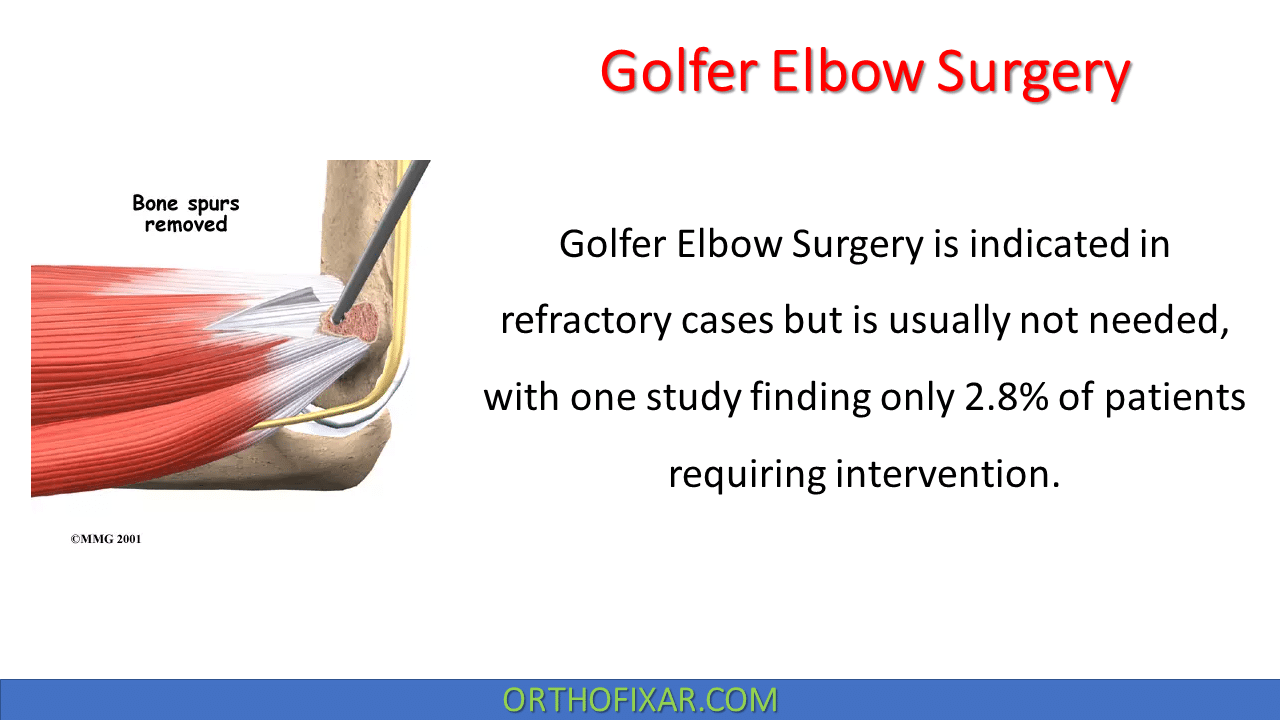Golfer Elbow Surgery

Golfer Elbow Surgery consists of release and remove the damaged common flexor tendon origin on medial epicondyle.
Golfer Elbow Surgery is indicated in refractory cases but is usually not needed, with one study finding only 2.8% of patients requiring intervention.
The medial epicondyle is the common origin of the flexor and pronator muscles of the forearm. The pronator teres, flexor carpi radialis, palmaris longus, and flexor digitorum superficialis originate on the medial epicondyle and are innervated by the median nerve. The flexor carpi ulnaris also inserts on the medial epicondyle and is innervated by the ulnar nerve.
Together these five muscles share the same origin, forming the conjoined flexor tendon of the medial epicondyle of the humerus. This tendon is approximately three centimeters long, crosses the medial ulnohumeral joint, and runs parallel to the ulnar collateral ligament where it serves as a secondary stabilizer.
See Also: Elbow Anatomy
Golfer Elbow Surgery Steps
- Begin by making a 5-cm incision, slightly curved, starting approximately 1 cm proximal and just posterior to the medial epicondyle. This posterior placement of the incision helps avoid sensory branches of the medial antebrachial cutaneous nerve located anteriorly and distally to the epicondyle.
- Retract the subcutaneous tissue and skin over the medial epicondyle to expose the common flexor origin.
See Also: Medial Epicondylitis

- To expose the pathological tissue, make a longitudinal incision in the tendon origins, starting from the tip of the medial epicondyle and extending distally for 3 to 4 cm.
- Elliptically excise the pathological tissue, including the joint capsule if necessary, while ensuring that the normal tissue of the attachment to the medial epicondyle remains intact.
- Close the elliptical defect using absorbable sutures.
- If symptoms or pathological anatomy are discovered during surgery, consider transposing the ulnar nerve.
- Close the subcutaneous tissue using absorbable sutures, and then suture the skin with a running subcuticular suture.
- Apply a dressing and immobilize the elbow with a posterior splint set at a 90-degree flexion angle.
See Also: Tennis Elbow Surgery

Aftercare
- The splint is removed 1 week after golfer elbow surgery, and elbow range-of-motion exercises are initiated.
- Strengthening exercises are started when full range of motion is achieved, typically 3 weeks after surgery.
- Strenuous activity can resume when the patient achieves normal strength without pain, which is typically 3 months after surgery.
- A longer period of immobilization and slower progression of rehabilitation are indicated in patients who had ulnar nerve transposition.
References & More
- Kiel J, Kaiser K. Golfers Elbow. [Updated 2023 Jun 26]. In: StatPearls [Internet]. Treasure Island (FL): StatPearls Publishing; 2023 Jan-. Available from: https://www.ncbi.nlm.nih.gov/books/NBK519000/
- Mercer’s Textbook of Orthopaedics and Trauma, Tenth edition.
- Sahu RL. Percutaneous golfer’s elbow release under local anesthesia: a prospective study. Rev Bras Ortop. 2016 Sep 20;52(3):315-318. doi: 10.1016/j.rboe.2016.06.007. PMID: 28702390; PMCID: PMC5497005. Pubmed
- Lifetime product updates
- Install on one device
- Lifetime product support
- Lifetime product updates
- Install on one device
- Lifetime product support
- Lifetime product updates
- Install on one device
- Lifetime product support
- Lifetime product updates
- Install on one device
- Lifetime product support